Video surveillance systems have been left out in the simulation world for decades. But new technologies are spawning some amazing new systems. Like most other video equipment today, its development direction is based on Internet Protocol (IP), digital, wireless, and unmanned surveillance systems with intelligent software, and can fully utilize all the benefits of these technological improvements. Today's latest system contains many new features:
Monochrome to color: Although it is not really a new trend to break away from the black and white world, this situation continues. In fact, most monitoring equipment today is in color.
Analog to digital: Although more than 80% of surveillance cameras are older analog devices, most newly installed devices are digital devices.
Higher resolution: With the rise of digital video cameras, resolution has evolved from standard definition (SD) television standards to multiple video formats including 720 and 1080 high definition (HD) standards.
IP cameras: Most new high-definition cameras are also IP cameras. These cameras can digitize the signal, package the data with TCP / IP, and then send the resulting data over the Ethernet link.
New compression method: Digital cameras can produce ultra-high data rates for high-definition video. However, the new video compression standard not only greatly reduces the transmission data rate, but also fully improves the storage capacity. Motion JPEG, MPEG-4 and H.264 are the most commonly used compression methods.
Wireless connection: In most systems, the link from the camera to the monitoring center still uses coaxial cables. However, some new systems use an Ethernet local area network (LAN) or a newly installed new CAT5 / 6 LAN. Fiber optics are even used in some high-end systems. However, due to convenience and low cost, wireless connection has become the preferred link for the expansion of many new systems or existing wired systems.
Disk storage: Video archiving has evolved from VHS VCR to hard drives. DVRs and dedicated servers can store compressed video for a specified period of time. Large systems even use 2Tb disk arrays.
Video analysis technology: With the popularity of high-definition digital video, a computer or FPGA can be used to analyze the captured scenes, thereby achieving intelligence. Video analysis technology uses artificial intelligence algorithms and machine vision technology to detect motion, recognize objects and even human faces. Most experts agree that the only way to process a growing number of videos is to use intelligent video analysis technology to partially or completely replace manual analysis of captured video.
Video camera
There are currently two basic types of cameras: analog and digital IP. The appearance of these two cameras is rich and changeable. Bullet type is the most common, but hemispherical and pinhole "spy" cameras are also popular. There are also indoor and outdoor models. Although there is still a market for monochrome cameras, most are color cameras.
The basic imaging sensor can be a charge-coupled device (CCD) or CMOS. CCD has developed very maturely, it is the first choice sensor for cameras with extremely high resolution but speed is not the most important factor. The resolution of the CMOS sensor has almost caught up with the CCD, but it is still slightly behind. CMOS can provide very high speed, suitable for occasions requiring maximum frame rate.
There is also an infrared (IR) camera using an infrared sensor on the market, which can literally be used for night photography. The front of the infrared camera usually has a set of infrared LEDs, which are used to illuminate scenes or objects that the human eye cannot see. The illumination distance of these LEDs is usually limited to hundreds of feet.
Resolution is a key indicator of the camera. The most common is the old-fashioned analog standard NTSC video, with a total of 525 lines (480 lines visible) of scan lines interlaced at 30 frames per second (fps). There are also PAL, SECAM and CIF (Common Intermediate Format) resolutions. The resolution is quantified as TVL resolution or simplified as LOR. The 380 (minimum), 400, 420 and 480 lines are the basic line numbers. Higher resolution analog cameras provide 560, 600 or 700 LOR.
The current popular CIF standard uses 352 × 288 pixels and the speed is 30 frames per second. The NTSC CIF derived from NTSC has 352 × 240 pixels. The quarter CIF has 176 × 144 pixels. 4CIF can provide 704 × 576 pixels, while 16CIF claims to provide 1408 × 1152 pixels. Some systems use Sony's D1 video format, which is a SMPTE VTR standard that supports 720 × 480 (for NTSC) and 720 × 576 (for PAL) pixels.
Digital IP cameras can provide higher resolution. Standard VGA with 640 × 480 pixels is very popular. Common pixel resolutions range from about 1 million pixels to 12 million pixels or even higher. There are also 720 or 1080 LOR cameras on the market like standard HD TVs, but the price is high. There are also higher resolution cameras for the professional field.
Closely related to resolution is the frame rate. Although 30fps is considered a real-time rate, it will generate a huge amount of video for storage or transmission. To save storage space, some cameras offer a lower frame rate of 15 or 7.5fps. There are also cameras with frame rates as low as 1fps, but at such a low frame rate some key actions may be missed.
Lens and physical controls are also worth considering. The type of lens varies depending on the specific application, such as whether to shoot macro or long distance, or whether a special angle of view is required. Some lenses use a motor to remotely control the aperture and focal length. There are also fixed bracket cameras and cameras that can move horizontally and tilted and have a zoom (PTZ) function. You can even buy imitation cameras with red flashing LEDs that make people think they want to go on TV.
Many cameras use microphones for sound capture and include motion detection circuits, and only turn on the camera or video recorder when motion is detected. In terms of power supply, most cameras work under 12V or 24V DC power supply. Some cameras also use battery power. IP cameras connected to an Ethernet LAN can use Power over Ethernet (PoE).
In terms of connectivity, analog cameras use standard IEEE video signals, which are transmitted on 75Ω coaxial cables (RG-59 or RG-6). The maximum transmission distance is about 300 feet. Analog video can also be transmitted on UTP cable like CAT5, but it is not common. The IP camera has an RJ-45 connector and a 10/100 Ethernet port (Figure 1), with a transmission distance of up to 100 meters. Most IP cameras are actually a small network server with their own IP address. People can monitor such cameras from anywhere via the Internet.

Figure 1: A typical IP camera contains sensors and video processing circuits for H.264 compression. SDRAM provides storage for video streams. All other processing and interfaces are usually located on a single SoC or FPGA.
The signal output from the CCD or CMOS imager in the IP camera is already a digital signal. The latest wide dynamic range (WDR) CMOS sensor can directly output the RAW / Bayer digital format data stream using the RGGB color scheme. This output can reach 20 bits / pixel. The data rate will increase rapidly under high frame rate and high definition. E.g:
20 bits / pixel × (1280 × 720) pixels / frame × 60 frames / second = 1.10592 Gbps
The core of this design is a fast processor with flash memory and SDRAM, and provides video encoding and compression functions. The design also supports a variety of interfaces and Ethernet interfaces (usually 10 / 100Mbps), but some also provide 1Gbps Ethernet interfaces. Most designs use a single system-on-chip (SoC), that is, an FPGA or a dedicated DSP to perform all functions. These chips generally contain interfaces. The memory is located in a separate chip (refer to the article "Video Surveillance Compression, Bandwidth, And Storage").
Wireless monitoring
Although the latest development trends in resolution, IP connectivity, and analysis technologies have made video surveillance better than ever, wireless technology has contributed the most to the popularity of video surveillance. Cable installation costs are high and time consuming, which is often annoying. Moreover, the cable sometimes limits the placement of the camera, so that the best visual effect cannot be obtained.
The wireless link can solve these problems. After installing a high-performance wireless modem for each camera, the connection can be established anywhere up to the central collection point. Installation is super fast and convenient, and the cost is several orders of magnitude lower than the cable. The wireless method is feasible because this technology can now support the high data rates required for transmission over a reasonable distance.
Video cameras can use one of three basic wireless topologies: point-to-point (PTP), multipoint-to-point (MTP), and mesh topology. In small, simple systems, direct PTP is usually a good solution. Some systems can support multiple PTP connections. In the MTP topology, multiple cameras use a single wireless collection point where data is aggregated, stored, or processed. However, when the camera exceeds the range of the main MTP control node, a mesh topology solution is used.
Wireless mesh networks have been developed for many years, and the industry has introduced many systems with excellent performance. In a mesh system, each node can usually communicate with any other nodes in the vicinity. Each node can be used as a repeater, complete data transmission and reception, or forward data to neighboring nodes. This forwarding function allows cameras and nodes to be spread over a large range, and this range generally exceeds the limits of a single wireless device.
Wireless devices are usually digital and are designed to carry Ethernet data packets. Most of them are compatible with the latest IP cameras. However, earlier analog systems can also be compatible with wireless devices through data converters. The role of these data converters is to digitize and group the analog output signals into Ethernet data packets suitable for wireless transmission.
The choice of wireless technology depends on many factors, such as coverage, reliability, cost, and required data capacity. Perhaps the most widely used wireless technology is Wi-Fi technology, the popular IEEE 802.11 standard that uses the 2.4GHz band or 5.8MHz band (in some cases). This technology is designed for Ethernet and can quickly and easily match any wired Ethernet LAN.
The 802.11a / g data rate may be as high as 54Mbps, and the typical value for IP transmission is 22Mbps. With the introduction of 802.11n devices, even higher data rates over 100Mbps can be achieved. The use of Multiple Input Multiple Output (MIMO) technology has greatly expanded the coverage and reliability of 802.11. Directional antennas can also extend the range to several miles. In addition, there are a variety of proprietary 2.4GHz wireless technologies on the market.
Although 900MHz wireless devices used to transmit video are rare, they are also used where ultra-long-distance transmission is required. Frequency shift keying (FSK) or simple direct sequence spread spectrum (DSSS) modulation techniques make them very reliable in noisy areas or where there are many other 2.4 GHz interference sources. Due to its inherent robustness, 900MHz wireless devices are very popular in UAVs.
Another technology that can meet the needs of faster speeds and longer distances is WiMAX. This broadband wireless technology can reliably transmit high-speed data for miles away. WiMAX systems are usually licensed, and the 2.3GHz band is used in the United States. The 5.8GHz frequency band is also widely used in the United States. In some special cases, even machine-to-machine (M2M) cellular or microwave / millimeter wave return systems are used.
The coverage depends largely on various factors, such as operating frequency, transmit power, receiving sensitivity, antenna type, antenna gain and height, and environmental conditions. Hundreds of feet is easy to achieve in most cases, but covering a few miles requires special equipment.
The required data rate is also a key consideration. This requirement ultimately comes down to these contents: video format, frame rate, compression type, and the upper limit of wireless technology. Most wireless devices can easily handle compressed video. Even with the CIF format of MPEG4-SP at a frame rate of 30fps, the maximum data rate required is only 600kbps. Even with high-definition video and reasonable frame rates using H.264, data rates exceeding a few Mbps are rare. All these rates are within the specifications of most available technologies.
Reliability is another issue. Today's wireless links are no less reliable than wired systems if they are designed correctly. The design goal of the wireless link is to create additional attenuation margins to adapt to the weather and changing environmental conditions, such as moving objects, tree growth or wind blowing, and new buildings. Finally, there is the issue of security. With encryption technology and even directional antennas, existing equipment can meet most security requirements.
Most new IP systems use wireless technology because they are faster and easier to install, not to mention cheaper. The existing wired LAN can usually be used to transmit video when the system scale is not too large. The wireless modem can easily extend the wired system. In addition, don't forget the potential to integrate with existing simulation systems. Such hybrid systems are very common.
Products and systems
There are already an alarming number of products on the market supporting the development of higher resolution IP video surveillance systems.
Allied Telesis produces Ethernet switches for video systems. Such switches are important components in large systems. Most large-scale systems require an independent Ethernet LAN to prevent overload of IT networks caused by huge video traffic. The data volume of up to 4 to 7MB per IP camera in a large surveillance network is likely to exceed the load capacity of any corporate LAN.
In an optimized system, each camera sends its data to the switch, which then communicates with the storage server, client PC, and monitor to complete access to the video stream and control the system. Allied Telesis' AT-8100S stackable switch is designed for these video surveillance systems (Figure 2).
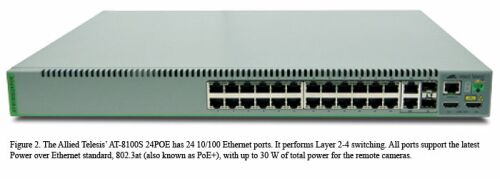
FPGA supplier Altera also aimed at the video surveillance market and launched a high-definition IP camera reference design based on a single FPGA. This solution uses Altera's low-cost Cyclone III or Cyclone IV FPGAs and intellectual property provided by EyelyTIcs and Apical.
The above design can be used with AltaSens' 1080p60 A3372E3-4T and ApTIna's 720p60 MT9M033 high-definition wide dynamic range (WDR) CMOS image sensor. Compared with the architecture using traditional DSP and special application standard products (ASSP), the design goal is to reduce the board area and power consumption, increase flexibility and shorten development time.
Traditional DSPs and ASSPs do not have the processing power required to accept large bandwidth data from 1080p and 720p WDR CMOS sensors. For example, a full HD raster image has 2200 × 1125 pixels, each pixel exceeds 16 bits, and the number of frames per second is 60 frames, so the final data bandwidth exceeds 2Gbps. Altera's FPGA can provide such bandwidth. Altera's HD surveillance IP camera reference design includes:
Apical ’s ISP, which integrates world-class WDR processing “dynamic range correction (iridix)†and advanced spatiotemporal noise reduction functions;
Apical's "Checkerboard Demosaicking" kernel for Altasens A3372E3-4T WDR mode;
"3A" function, such as automatic exposure and automatic white balance realized by software on Altera's Nios II embedded soft core processor;
EyelyTIcs' H.264 video encoder can achieve the main class 720 line progressive 30 frames per second encoding or 1080 line progressive 15 frames per second encoding capability;
Altera's three-speed Ethernet media access controller (MAC) intellectual property core.
Because no DSP or ASSP is required, and all these functions are integrated into a single Altera FPGA, the design engineer can reduce the board area, thereby saving costs and reducing power consumption. Compared with previous designs, Altera's single-chip solution can reduce power consumption by more than 50%.
Bundling a full set of intellectual property rights in this reference design allows designers to quickly start camera development, and development time can be shortened by up to one year. All the camera designer has to do is to customize the FPGA with his own special functions, such as adding his own software for motion detection and pan, tilt and zoom control.
Basler also produces high-quality modern IP cameras (Figure 3). They provide fixed brackets and hemispherical versions. Different models provide different resolutions, such as 640 × 480, 1024 × 768, 1280 × 960 and 1600 × 1200 pixels. All models use Sony's Wfine progressive scan CCD image sensor.
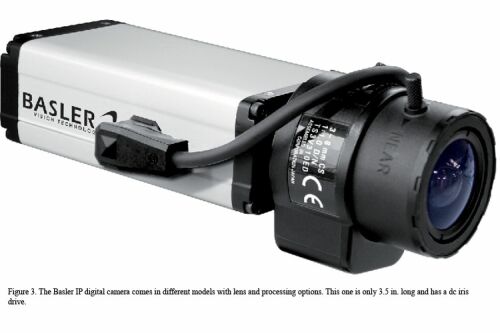
Figure 3: Basler's IP cameras provide different lenses and processing depending on the model. The picture shows a product with only 3.5 inches and DC drive aperture.
The frame rate depends on the resolution and compression mechanism, ranging from 30 fps at lower resolution to 4 fps at highest resolution. The camera supports motion JPEG, MPEG-4 and H.264 compression standards. The CCD output signal is digitized in an analog-to-digital converter (ADC) and sent to the FPGA for initial processing, and then sent to an internal dual-core 600MHz DSP with 128MB RAM and 8MB flash memory.
I / O is a standard 10/100 Ethernet interface, and RS-232 interface can also be used if necessary. Power is supplied via PoE or 7V to 20V DC power. The multi-encoding function allows multiple data streams to be realized. The image can also be zoomed. The interest domain feature allows users to define customized areas within the original field of view. It can also realize motion detection with alarm.
Although most high-definition video surveillance will use wireless links or CAT5 / 6 Ethernet transmission, there is still a certain market for coaxial cables. Ignoring the large number of installed RG-59 or RG-6 coaxial cable infrastructure seems to be a waste. It is now possible to transmit high-definition video through this coaxial cable, thanks to the Aviia (Advanced Video Interface for Industrial Applications) system introduced by Gennun, which can transmit high-definition video on coaxial cable. Existing analog CCTV users only need to disconnect the camera and some other equipment to upgrade to high-definition, without re-wiring with CAT6 / 6 UTP or switching to wireless connection.
The Aviia transmitter (TX) and receiver (RX) chipsets support 8, 10 or 12-bit component digital video. It provides serial interfaces for standard definition 525i or 625i formats and HD 720p formats at 24, 25, 30, 50 and 60fps. Other formats offered include HD1080i at 50 and 60fps or 1080p at 24, 25, 30, 50 and 60fps.
The transmission distance in HD format can reach 160 meters on RG-59 and 230 meters on RG-6. The transmission and reception distance in the standard definition format is farther, up to 330 meters on the RG-59 and 440 meters on the RG-6. The direct current (PoC) function of the cable is designed for remote cameras. The 6Mbps auxiliary data channel for remote control is also an important feature. The system allows up to 8 audio channels to be included in the format.
The Aviia chipset is based on Gennum's advanced serializer / deserializer technology. The transmitter is designated as GV7600, and the receiver GV7601 uses cable equalization technology. These devices use standards initiated by the HDCCTV Alliance. This technology was specifically developed for radio and television.
The video is sent without compression and is not encapsulated by TCP / IP. In the end, such a system can be obtained: the camera can be inserted into the receiving device, the video transmission has a minimum delay, and the configuration is very few.
The data rate is 270Mbps in standard definition format, 1.485Gbps in high definition format, and 2.97Gbps in 1080p format at 50 / 60fps frame rate. The chip is now available and provides a reference design. Other applications include digital labels, machine vision and video conferencing.
Intersil's Techwell Division also uses a large number of chips to support the design of video surveillance equipment. For example, their TW6864 and TW6868 multi-channel video capture chips are highly integrated single-chip solutions that support multi-channel real-time video and audio capture through the PCI Express x1 interface, which is ideal for PC DVR applications.
Each chip claims to have 4 high-quality NTSC / PAL / SECAM video decoders, which can convert analog composite video signals into digital components of YCbCr data. They also use adaptive 4H comb filters to separate brightness and chrominance to reduce cross noise artifacts. The TW6864 and TW6868 include a high-performance proprietary DMA controller that can make full use of PCI Express x1 bandwidth, which enables it to transfer video and audio data at the optimal throughput rate.
These devices support a wide range of video applications, including simultaneous decoding and transmission of 4 channels of real-time D1 video, or up to 16 channels of non-real-time video. They also support multiple video display formats, such as D1, half D1 and CIF.
By implementing Techwell's advanced proprietary video switching technology, these chips have industry-leading video lock speed in non-real-time switching mode. In addition, with the external Techwell four-channel decoder, the TW6868 can transmit up to 8 channels of real-time D1 video and 9 channels of audio output.
Maxim Integrated Products' (Maxim Integrated Products) company's Mobicam3 IP camera reference design kit is based on Maxim's MG2580 SoC, which integrates most of the circuitry required for IP cameras. The chip can process CIF, D1 and 720p video, and provides up to 12 million pixels of H.264 and M-JPEG decoding function. The chip also contains audio codecs that meet G.722, AMR, AAC, and MP1 / 2/3 standards.
The MG2580 chip integrates ARM9 with Ethernet and USB I / O. Its basic video analysis functions include motion detection, tripwire and image tracking. The Mobicam3 kit also lists a complete set of other linear products from Maxim, which can be used to form a complete camera.
Texas Instruments (TI) also has a complete series of surveillance video chips, reference designs and software (Figure 4). These devices are derived from the TI DaVinci (DaVinci) series of video processors based on the famous TMS320 DSP.
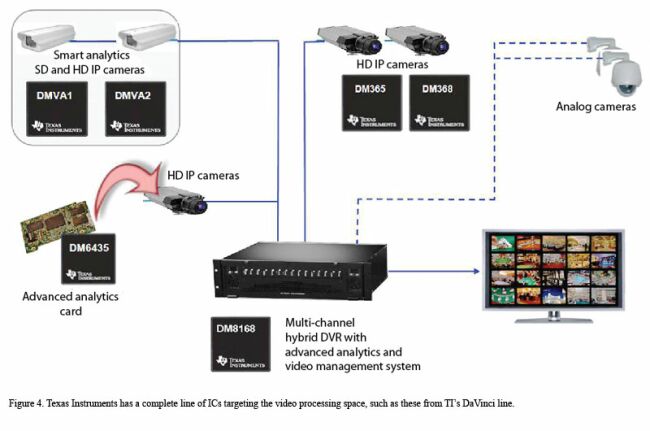
Figure 4: TI has a series of complete IC products for video processing, these devices are derived from TI Da Vinci series video processors.
DMVA1 and DMVA2 video processors are mainly used in the field of IP cameras. These SOCs are based on TI's TMS320DM643x DaVinci platform and contain a 300MHz ARM9 core. Both devices have video analysis capabilities, including people counting, trigger zone, motion detection, camera tampering detection, and streaming media metadata. They support H.264, MPEG-4 and M-JPEG compression, and can process D1 video at 30 frames per second and 720p video at lower frame rates. Reference designs based on Aptina 5MP CMOS imager and Linux software are now available.
DM365 and DM368 are also on-chip video processors designed for IP cameras but without analysis functions. Reference designs are also available. DM6435 is a digital media processor, mainly used for high-definition IP cameras. TI also provides video analysis cards based on DM6435.
The DM8168 SoC integrates all capture, compression, display and control functions into a single chip. It can handle multi-channel parallel HD, D1 and CIF video encoding and decoding, while supporting H.264, MPEG-4 and VC1 video formats at high resolution. This SoC contains all necessary interfaces, such as Gigabit Ethernet, PCI Express, SATA2, DDR2 / 3, USB 2.0, MMC / SD, HDMI and DVI. DVR is one of its application examples.
VideoIQ provides an innovative approach in its iCVR camera (Figure 5). This type of camera is available in standard definition and high definition. The HD model uses the normal 1080p format at a 30fps frame rate. The company's unique approach is to embed storage and intelligence inside the camera. The HD sensor produces full-color video, which is compressed with H.264, and then stored on a 500GB internal disk.
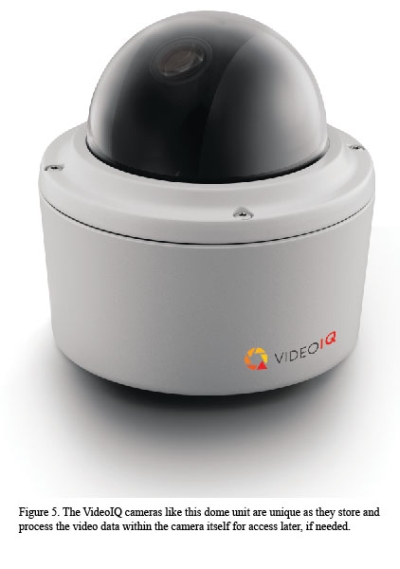
Figure 5: VideoIQ's hemispherical cameras as shown in the picture are very unique. They store and process data inside the camera for later access when needed.
Use an internal Linux-based computer to store intelligent software. This software contains video analysis functions and other algorithms that can be used to grasp the surrounding environment and apply general status to streaming media data. The main benefit of this method is that instead of using an Ethernet connection to send the video stream to the server, it can be stored internally.
This is a good method because most surveillance videos are not continuously observed. These videos can be stored for later access when needed. Each camera itself is a complete system. The connection is completed via Ethernet backhaul to the monitoring system server. Generally, it is powered by PoE, but you can also use the traditional 24V or 12V DC power supply.
Digital high-definition makes today's video surveillance more complete, which is a big step forward for video surveillance systems. After all, as Ed Strong of Western Digital asked: "If you can't generate details that can be used as evidence, what other benefits does surveillance have?"
Although high-definition video provides detailed data, you still have to store the video for later access. Fortunately, there are compression technology and some new large-capacity hard drives, which make storing data a reality. Western Digital has launched new hard drives optimized for the surveillance market.
Western Digital's WD AV-GP series hard drives now include 2TB products (Figure 6), which is by far the industry's largest hard drive. WD AV-GP hard drives with WD GreenPower technology provide easier cooling and quieter operating modes, and have lower power consumption.
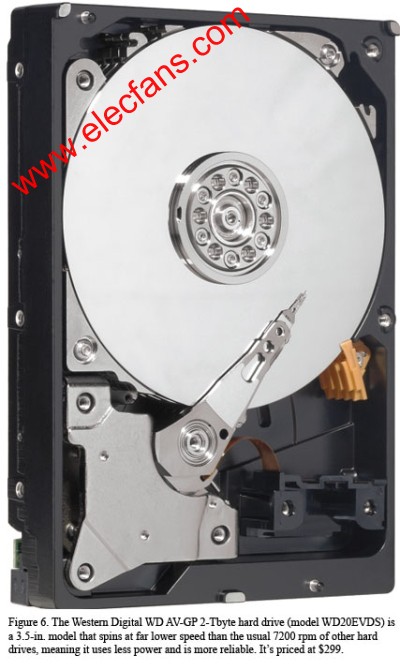
WD AV-GP hard drives are designed to withstand the strict environmental requirements of the surveillance and security markets. Compared with similar standard hard drives, power consumption can be reduced by 40%. The WD AV-GP 2TB hard drive is ideal for DVR and surveillance video recording applications that require larger capacity hard drives and extremely high reliability. These hard drives are designed to work uninterrupted.
We offer Phone Glass Protector, iPhone Glass Screen Protector, Tempered Glass for iPhone
Features:
|
Feature |
Thickness: 0.33mm |
|
Hardness: 9H |
|
|
Anti-oil, easy absorption |
|
|
Super high-definition for true color display, enjoy your visual feast |
|
|
Our cell phone protective films can anti-smudge and anti-fingerprints protection |
|
|
Anti-scratch and explosion-proof |
|
|
Provide supreme and nice appearance , our tempered glass protector make people feel comfortable and smooth grip |
|
|
Bubble-free and easily absorb |
|
|
Lead time |
7-9 working days/ Sample lead time : 1-4 days |
|
Package |
crystal boxes and Blister box packing available |
|
Payment |
T/T, Western Union, L/C, PayPal |
Glass Screen Protector
Glass Screen Protector,Tempered Glass Screen Protector,Anti Fingerprint Glass Screen Protector,Iphone 6 Plus Screen Protector,Iphone 6 Screen Protector,Iphone 6S Screen Protector,Iphone Glass Screen Protector,Tempered Glass For Iphone
Hebei Baisiwei Import&Export Trade Co., LTD. , https://www.baisiweicable.com